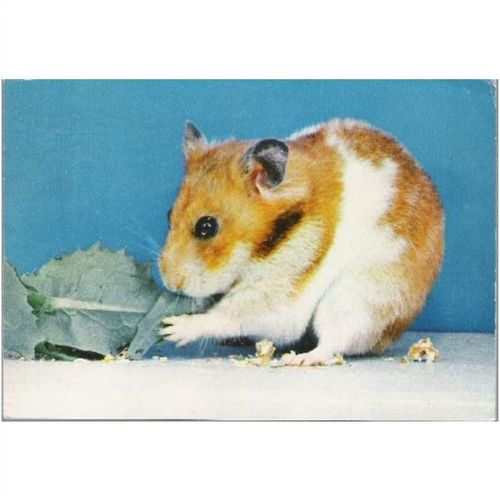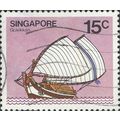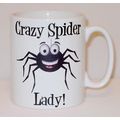Animal - Golden Banded Hamster - Dixon postcard 1974
- Condition : Used
- Dispatch : 2 Days
- Brand : None
- ID# : 122803424
- Quantity : 1 item
- Views : 678
- Location : United Kingdom

- Seller : justthebook (+1699)
- Barcode : None
- Start : Wed 04 Dec 2013 05:56:45 (EDT)
- Close : Run Until Sold
- Remain : Run Until Sold
Checks/Cheques
 for 1 item(s) edit
for 1 item(s) edit
Shipping Calculator
More Listings from This Seller view all
Seller's Description
- Postcard
- Picture / Image: The Golden Banded Hamster
- Publisher: J Arthur Dixon (Pets 7232)
- Postally used: yes
- Stamp: 3&half p. olive Machin defin.
- Postmark(s): Moreton in the Marsh 21 March 1974
- Sent to: Thompson Road, The Uplands, Stroud, Gloucestershire
- Notes / condition:
Please ask if you need any other information and I will do the best I can to answer.
Image may be low res for illustrative purposes - if you need a higher definition image then please contact me and I may be able to send one.
------------------------------------------------
Postage & Packing:
UK (incl. IOM, CI & BFPO): 99p
Europe: £1.60
Rest of world (inc. USA etc): £2.75
No additional charges for more than one postcard. You can buy as many postcards from me as you like and you will just pay the fee above once. (If buying postcards with other things such as books, please contact or wait for invoice before paying).
Payment Methods:
UK - PayPal, Cheque (from UK bank) or postal order
Outside UK: PayPal ONLY (unless otherwise stated) please. NO non-UK currency checks or money orders (sorry).
NOTE: All postcards are sent in brand new stiffened envelopes which I have bought for the task. These are specially made to protect postcards and you may be able to re-use them. In addition there are other costs to sending so the above charge is not just for the stamp!
I will give a full refund if you are not fully satisfied with the postcard.
----------------------------------------------
Text from the free encyclopedia WIKIPEDIA may appear below to give a little background information (internal links may not work) :
*************
The golden hamster or Syrian hamster, Mesocricetus auratus, is a member of the rodent subfamily Cricetinae, the hamsters. In the wild, they are now considered vulnerable. Their numbers have been declining due to loss of habitat caused by agriculture and deliberate destruction by humans.[1] However, captive breeding programs are well established, and captive-bred golden hamsters are popularly kept as pets and used as scientific research animals.
The size of adult animals ranges from 5 to 7 in (13 to 18 cm) long, with a lifespan of two to three years.[2] In captivity, the golden hamster is most active at night, but in the wild, it is a crepuscular animal. Wild hamsters sleep during the day in the deepest part of their burrows to avoid predators and wake up after sunset, being active on the ground for a few hours in the early and late parts of the night.
Like most members of the subfamily, the golden hamster has expandable cheek pouches, which extend from its cheeks to its shoulders. In the wild, hamsters are larder hoarders; they use their cheek pouches to transport food to their burrows. Their name in the local Arabic dialect where they were found translates to ""mister saddlebags"" (Arabic: ??? ????) due to the amount of storage space in their cheek pouches.[citation needed] If food is plentiful, the hamster stores it in large amounts.
Sexually mature female hamsters come into season (oestrus) every four days. Golden hamsters have the shortest gestation period in any known placental mammal at only 16 days. Gestation has been known to last up to 18 days, but this is rare and almost always includes complications. They can produce large litters of 20 or more young, although the average litter size is between eight and ten pups. If a mother hamster is inexperienced or feels threatened, she may abandon or eat her pups. A female hamster enters estrous almost immediately after giving birth, and can become pregnant despite already having a litter. This puts stress on the mother's body and often results in very weak and undernourished young.
Hamsters are very territorial and intolerant of each other, with attacks against each other being ubiquitous. Exceptions do occur, usually when a female and male come together when the female is in heat, but even so, the female may attack the male after mating. Even brothers and sisters, once mature, may attack one another. In captivity, babies are separated from their mother and by gender after four weeks, as they sexually mature at four to five weeks old. Same-sex groups of siblings can stay with each other until they are about eight weeks old, at which point they will begin to become territorial and will fight with one another, sometimes to the death. Infanticide is not uncommon among female golden hamsters. In captivity they may kill and eat healthy young as a result of the pups interacting with humans, for any foreign scent is treated as a threat. Females will also eat their dead young in the wild to prevent predators detecting them.
Golden hamsters mark their burrows with secretions from special scent glands on their hips. Male hamsters in particular lick their bodies near the glands, creating damp spots on the fur, then drag their sides along objects to mark their territory. Females will also use bodily secretions and feces. The female and the male can have scent glands in different places. The female's is on the hip, and the male's can sometimes be found around the stomach area.
type=printed postcards
theme=animals
sub-theme=hamster
period=single
period=1945 - present
postage condition=posted
Listing Information
| Listing Type | Gallery Listing |
| Listing ID# | 122803424 |
| Start Time | Wed 04 Dec 2013 05:56:45 (EDT) |
| Close Time | Run Until Sold |
| Starting Bid | Fixed Price (no bidding) |
| Item Condition | Used |
| Bids | 0 |
| Views | 678 |
| Dispatch Time | 2 Days |
| Quantity | 1 |
| Location | United Kingdom |
| Auto Extend | No |





















